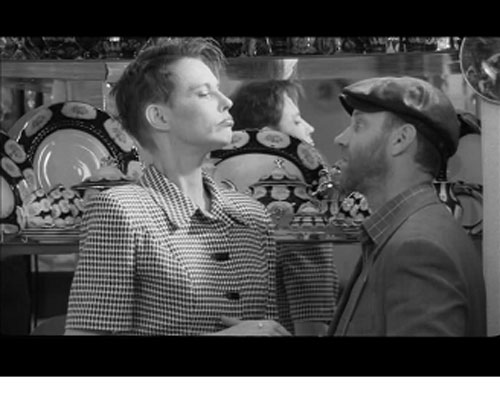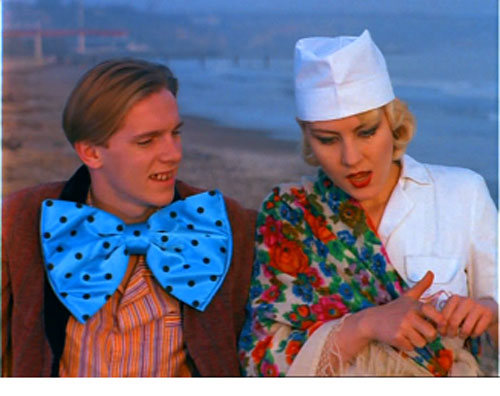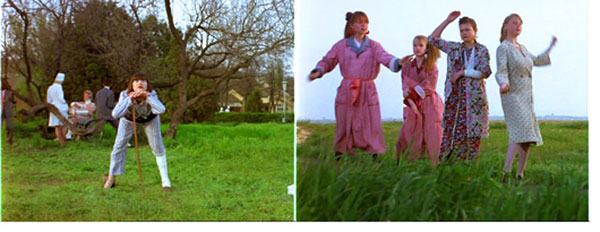KIRA MURATOVA. CINEMA OF SUBVERSION
a book by Isa Willinger

10. Circus Tricks and Eisenstein's "Montage of Attractions":
Traces of the Russian Film-Avant-garde in Muratova's Oeuvre
(Excerpts)
Eccentrics and FEKS
Muratova's films are without a doubt inspired by early film including the films of the Russian-Soviet Avant-garde. In my analysis of The Long Farewell, I already pointed out a form of triple jump-cut-montage that can also be found in Eisenstein. Also, I referred to a parallel in the plots of The Asthenic Syndrome and Dovzhenko's Earth.
Another one of Muratova's films, The Sentimental Policeman, is in many ways an homage to the era of silent film. On the one hand, the many doublings that define the formal principle of the film recall the Slapstick-style of early comedians. Muratova has more than once mentioned her profound love of Charlie Chaplin, whose films she saw as a young child1. On the other hand, the main character's clownish conduct is reminiscent of early film. Tolya's motoric, wooden gestures make one think of the biomechanical acting concept developed by Vsevolod Meyerhold, Eisenstein's teacher. So it is not surprising that in Tolya's apartment, there are two posters of the Black Square by Suprematist painter Kazimir Malevich - a kind of icon of the Russian Avant-garde and the revolutionary 1920s. However, the doubling of the poster expresses a slightly ironic distancing towards the Avant-garde. In spite of the borrowings, Muratova's films never simply imitate the Avant-garde. Certain elements are taken up and used, but they are also developed further.
While doubling, a technique much loved by Muratova, always refers to a mechanical principle, the obsessive doubling in The Sentimental Policeman appears like a satire of machine-like processes. To the artists of the Avant-garde, the machine was like a new God, as the many expressive shots of machines in Vertov, Eisenstein and other revolutionary filmmakers vividly demonstrate. In a similar vein, scenes in Muratova's The Sentimental Policeman and Two in One on the Odessa steps, where Eisenstein shot the key scene of Battleship Potemkin, also attest to a humorous distancing from the great master. In Two in One, when the main character is chased after on the steps, this pursuit ends happily for the pursued woman - in contrast to the massacre occurring on the steps in Eisenstein. In The Sentimental Policeman, Tolya tells his wife that he would like to adopt a baby in about the same place as in Battleship Potemkin a mother is shot with her injured son in her arms.2 Jane Taubman even discovers a parallel in the lighting of the scene in Muratova and Eisenstein. 3 These quotations - no matter how playfully they deal with the original scene - provide evidence of the significance of the Avant-garde's films and techniques in Muratova's oeuvre.
Another film by Muratova that references the era of silent cinema is the black-and-white-film The Tuner. The clownish hero, Andrey, entertains the other characters with exaggerated facial expressions, pantomime and little tricks, wearing a checked shirt with a dotted tie. Also, the high-contrast lighting in his apartment, as well as the immensely long stairway to his attic-floor, remind one of the films of the 1920s.
Other eccentric figures in Muratova as well as the director's overt love of circus tricks are reminiscent of the Factory of the Eccentric Actor ("fabrika ëkscentričeskogo aktëra"), or FEKS. This group, founded by Leonid Trauberg and Grigori Kozintsev, began by focusing on theatre, but turned to film in the mid 1920s. Muratova must know the films of FEKS, having studied at VGIK in the class of the director and actor Sergey Gerasimov, who acted in almost every one of the FEKS-films.
FEKS was inspired by circus, opera, German Expressionism and by American popular cinema. Their film The Devil's Wheel was shot in large parts in a documentary mode on a funfair. The young filmmakers Trauberg and Kozintsev had offered the lead role to Charlie Chaplin, who never accepted their offer, though.4 In their film The Overcoat, there is a number of awkwardly moving, eccentric looking characters, like a seamstress in checked pants, whose naked toes repeat the needle's movements when he is sowing. His female assistant with a cylinder, whose clothes are also made of diverse checked fabrics, moves like a puppet, opens her eyes widely, and rolls them.
Characters like these perform again and again in Muratova's films since the mid 1990s. Just think of Uta Kilter or sometimes even Natalia Buzko. However, the palette of eccentrics in Muratova is much broader than it was in FEKS-films.

Uta Kilter in The Tuner
Spectacle
In his article "The Cinema of Attractions" Tom Gunning describes the fascination of the international film avant-garde for the visual spectacle that film before 1906 presented in the pure form. "The cinema of attractions directly solicits spectator attention, inciting visual curiosity, and supplying pleasure through an exciting spectacle - a unique event, whether fictional or documentary, that is of interest in itself."5 The early filmmakers' concentration on the visual spectacle is, on the one hand, certainly connected to the then recent "discovery" of visuality by photography and film. At the same time, one can assume that the avant-garde movements, which were mostly oriented revolutionarily, took up film as their favorite art form, because an enormous animating effect emanates from cinematographic visual spectacles. "[I]ts energy moves outward towards an acknowledged spectator,"6 Gunning writes about early film.
Muratova's films, as we have seen in many examples, share this love of the visual spectacle. More so, they often use dialogue and narration to disturb signification, or to disrupt what Aleida Assmann calls "the deciphering gaze"7, throwing the spectators back onto a sensual kind of perception.
Even if Muratova's third film Getting to Know The Big Wide World (1979)8 already contains theatrical moments, the director only arrives at a truly spectacle-like film language in The Asthenic Syndrome (1989). Intense coloring or ornamentation, on the one hand, and performances that are isolated from narration, on the other hand, have been marking her films ever since. Little Passions with its colorful sets and costumes stands exemplary for this.

Intense colors and multible ornaments in Little Passions
Several times in the film the circus artist Violetta erupts into a dance. Once, in front of the hospital on a bright green lawn, she turns away from the other characters, steps aside and performs a dance number with a walking stick to four random patients who happen to be there. The four girls, as if kinetically infected, begin to do a dance move themselves, each one a different one. In this scene, it seems like Muratova wants to demonstrate to us a transmission of motion through watching, similar to the Carpenter-effect: William Carpenter observed in the 19th century, that watching a movement creates the motoric tendency to imitate it. This physiological discovery greatly fascinated the early filmmakers. Eisenstein, for example, knew the Carpenter-effect well and based his film theories and practices on it.

Intense colors and multible ornaments in Little Passions
Montage of Attractions in Eisenstein and Muratova
I dedicated a large part of this book to Muratova's extraordinary film language, describing it as physically and sensuously involving the spectators. Sergey Eisenstein's theories on attractions and later on pathos and ecstasy are strongly physically oriented. Acknowledging an intense sensual stimulation in Muratova's films thus establishes certain continuity within Soviet-Russian film history - a film history that has been first and foremost marked by a big fracture caused by the decree of Socialist Realism in 1932.
I have shown how Muratova's montages often do not serve to develop the film's plot further, rather, in her montages, Muratova combines scenes or shots constituting visual or energetic contrasts. Although in Eisenstein's films, plot elements do not drift apart as much as it is the case in Muratova, his montage of attractions functions according to a similar contrasting principle as Muratova's montage sequences of divergent affects.
In order to portray Eisenstein's montage of attractions, it is constructive to turn to his film Strike, after the production of which Eisenstein put down in writing his theory of attraction-based editing. In Strike, one element of the plot, the conspiracy of the workers, is staged through several succeeding short scenes, all loaded with attractions. Watching this sequence carefully, it becomes evident that Eisenstein's montage of attractions is defined by a clashing of divergent modes of movement, pictorial compositions, lighting, moods and metaphorical associations. In the first scene of this conspiracy-sequence, the workers are assembling on the factory territory. The images of the scene are dynamic and the composition is made up of many lines and large areas of shade. The following scene, showing the workers discussing as they are sitting on a pile of iron wheels, contrasts the first one in many respects: now, the round shapes of the wheels and the circle of people determine the scene graphically. The iron wheels emanate stability and grounding in opposition to the dynamism of the scene before. The lighting, too, is in contrast to the scene before: now, the characters are sitting in bright sunlight. This contrasting principle continues further through several succeeding scenes, including also some motifs that are attractions in themselves, like the conspirators jumping pike-like into the water, or climbing acrobatically up a large iron anchor.
Similar to Eisenstein's montage of attractions, Muratova frequently edits sequences full of attractions and contrasts. In her film The Asthenic Syndrome, the dramaturgical structure is repeatedly fashioned in a way that the succession of scenes is characterized by the clashing of divergent affects, rather than by narrative logic. An intensely exhibited affect contrasts with the scene before and after. In the most conspicuous of these montage-"chains", the characters change with each scene as well. Even though the narration is not developed any further throughout this chain, the sequence is permeated by tension.
In the sequence, the teacher Nikolai is walking through the streets. He walks past two kissing couples who are both rotating at the same time as they are kissing. The camera sticks with the second couple, as Nikolai disappears from the frame. Even within the shot, there are attractions and one contrast: On the one hand, the couples' doubling and rotating remind one of buffoonery, on the other hand, their intense kissing stands for love or eroticism and is in contrast to the clowning.
All of a sudden, a furious voice starts to shout from a distance: "They killed Kolya! They killed Kolya!" The affect of love or eroticism now clashes with an affect of fear or fury. The kissing couple becomes aware of the shouter, turns towards him and a short dialogue takes place between the apparently acquainted people. Then, the camera follows the furious shouter, whose name is Sergey, into an old apartment building. Inside, Sergey runs past an elderly, simply dressed woman turned towards the camera, who is singing a rhyming folk song about Stalin: "We had a fantastic life / when Stalin was still alive / He improved the working people's / living conditions." The camera sticks with the woman, until she has finished her song, while Sergey has disappeared from the frame. Sergey's horror and the hardship of today's reality, when people are getting killed, are contrasted with the old woman's nostalgia and glorification of the past.
After the song has ended, there is a cut to a close-up of Sergey, who wears a ski cap with a small photo of Gorbachev on his forehead, as we now recognize. Sergey is standing at someone's door repeating several times: "Is Misha home? Is Misha home?" A heavily made-up elderly woman, highly adorned with jewelry, answers stiltedly: "First of all, good afternoon." Sergey's affect of horror and fear is followed by the stiltedness of the old lady. Her artificiality clashes with his genuine emotion. Sergey's absurd, random clothing collides with her exquisite appearance. A cut is made back to Sergey, who shouts: "Good afternoon! Good afternoon! Good afternoon! Is Misha home?"
This styliazed dialogue between Sergey and the artificial woman, who both repeat their lines several times, is then followed by a long visceral monologue by a simply dressed somewhat younger woman who complains anxiously about the problems to receive an apartment from the State. This chain of different characters and affects continues on for a bit, until we are back with Nikolai in his school.
The assemblage of intense contrasting stimuli, who carry further the tension or energy of a sequence is strikingly similar in Eisenstein and Muratova. In Muratova, however, it is less divergent pictorial compositions and changes of location which constitute the attraction, but the character's affects. In other films by Muratova, like Minor People, one can also spot such chainlike dramaturgical structures, in which, in lieu of a logical narrative development, attraction follows attraction.
In spite of the big similarity of this formal principle, Eisenstein's montage always finds a point of culmination: at the end of the sequence in Strike, the printing press prints pamphlets, the strike is about to start. However, Muratova's montage-chain full of affects does not amount to a triumph and not even to a distinct result. The sequence depicted above ends in an epic scene at a fish stand, where a scolding crowd is clustering. Muratova uses affective intensities, as Eisenstein had fathomed them, without taking over the propagandistic value that her predecessor drew from them.
Where Eisenstein's cinema agitates in terms of the October Revolution, class struggle and the building of the young Soviet State, Muratova's Asthenic Syndrome explodes ideology. In this film, Muratova even uses the chain of divergent affects and attractions to portray the decomposition of late Soviet society.
No doubt, Eisenstein's films, in spite of their accent on the formal components, are oriented towards the narrative. Nevertheless, parts of Muratova's films structurally bear a great resemblance to Eisenstein's editing. The significance of affects and attractions in Muratova's oeuvre, as well as a montage technique relying on contrasts and visual energy rather than on narrative continuity testify to this kinship. In accordance with Eisenstein's ideal, the cinema of Muratova produces something, rather than representing something.
In spite of these parallels, it is important to underline once more that Muratova's films, having a strong awareness of the arousing and exciting moment in spectacles, attractions and ecstasy, exaggerate these elements often and use them as strategies of estrangement. Muratova does not use the physical impact of a film to get across a message or to educate, but to make verbal meaning enigmatic and to deconstruct ideology. Her films, one could thus conclude, oscillate between attraction and deconstruction, between spectacle and parody.
1. See interview in this book.
2. Cp. Taubman 2005, p. 68.
3. Ibid.
4. Cp. Bulgakowa 1996, p. 136.
5. Gunning 1990, p. 58.
6. Ibid, p. 58.
7. Ibid, p. 58.
8. Cp. Yampolsky 2008, p. 48-50.
The book can be ordered at UVK



